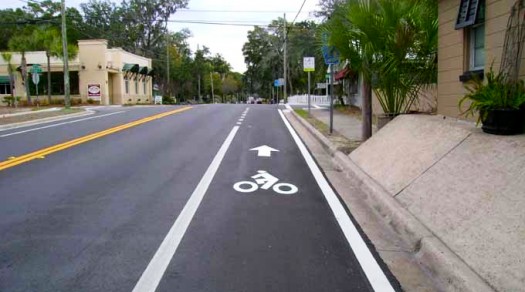A Placemaking Journal
Watch Your Words: Building support for walking and biking infrastructure
 In my last post, I looked at the difficulty of getting things — like walking and biking infrastructure — done and how the manner in which we measure our accomplishments makes all the difference. Not just towards building momentum but towards building community.
In my last post, I looked at the difficulty of getting things — like walking and biking infrastructure — done and how the manner in which we measure our accomplishments makes all the difference. Not just towards building momentum but towards building community.
In short, it’s all about baby steps.
But let’s say you’ve now taken some of those baby steps. Using my previous example, let’s say you got a bike lane installed. My guess is that, among your most ardent champions and supporters, no one’s looking to stop there. You’re looking for more. More routes, more options.
That’s where things start to get tricky.
Chances are, your initial foray into bicycling infrastructure picked the low-hanging fruit — the street with the fewest hurdles, both physical and political. But your next effort might be more difficult. Perhaps it’ll be a street that’s not grossly over-engineered, requiring something more than just re-striping.
Perhaps it’ll require more substantive public conversations about space allocation, nudging local perception across the line from cute community amenity to vehicular inconvenience.
How you tread next is very important because all too often, communities stumble by setting unrealistic near-term expectations.
People working towards more livable communities tend to be long-term thinkers who know whatever’s getting done today is just one step towards larger goals. But that’s not necessarily the norm for all the people just living their day-to-day lives. It’s critical that what you’re doing today be presented in ways that resonate with them, where they are in the here and now.
For example
Many places have significant long-term mobility goals. They recognize the potential benefits of alternative modes of travel and know that, when those options truly exist, the promise of congestion reduction becomes viable. That is, every person walking or rolling can be a car off the street.
But it’s a mistake to talk about that now.
A handful of bike lanes or sidewalks, while nice, is insufficient to offer viable alternative modes of travel for most people. It’s not until you develop meaningful networks wherein the infrastructure is extensive and fully connected — both within your community and beyond — that significant numbers of people begin examining their options.
You’ll get there, yes. Just not anytime soon. So don’t make that your pitch.
When you say “every bike is a car off the road” early in the process, you invite measurement. How many people are using your bike lane? Assuming you’ve no real network in place just yet, that number’s likely a small one. And will be for a while. Which to the people expecting congestion relief looks like failure.
Boondoggle, they cry! And you’ve given them the reason to feel that way. Good luck getting support or funding for your next phase.

This one bike lane’s not solving congestion. It’s not even impacting it in any appreciable way. It’s important you don’t suggest that it is.
Focus on what you can deliver
Instead, set expectations you know you can meet or exceed with each step. Every community’s different, and you know your community best, but your answer might more realistically involve selling your efforts on the basis of things like:
- Safety, particularly as it relates to kids
- Recreation and lifestyle
- Increased fairness and equity
These are things your efforts — today, right now — can deliver on. In ways that look like a win, which gives you not just the credibility to keep going but some increased political capital to spend when you get to the inevitably more difficult segments of your plan, like streets where new infrastructure significantly impacts current and accepted patterns of use.
Paving the way towards larger goals
As you build local support over time by delivering on the promises you’ve made and meeting the expectations you’ve set, you’ll have plenty of time to get people thinking about the bigger picture and the larger potential benefits slowly coming into view.
To that end, I recommend something that, given their ubiquity in livability discussions, might seem a radical tweak in your terminology:
Back away from the terms walkability and bike-ability and instead get people thinking in terms of walk-propensity and bike-propensity. That is, how likely is it that what we’re doing is going to get more people walking and rolling?
Talking about walking and biking propensity establishes a baseline understanding among your constituents that each new sidewalk or bike lane improves overall performance, and that the design of those facilities is equally pertinent. The better the network, the higher the propensity. And then, finally, the promise of walking and biking as true alternative modes of transportation — and with it, as potential solutions in addressing automotive congestion — becomes a viable proposition. One you can tout and realistically deliver on.
This revised framing further opens the door to other conversations as well. Conversations not everyone recognizes as related — like land use, development form, street geometry, and the nature of public space — but that definitely play a role in how people want or choose to get around. That’s a critical factor when you start talking not just about transportation but about larger livability issues.
Infrastructure obviously needs a physical implementation strategy, but it should also include an engagement strategy that meets people where they are and helps move them, slowly and methodically, towards shared benefit. Careful communications can help.
If PlaceShakers is our soapbox, our Facebook page is where we step down, grab a drink and enjoy a little conversation. Looking for a heads-up on the latest community-building news and perspective from around the web? Click through and “Like” us and we’ll keep you in the loop.


